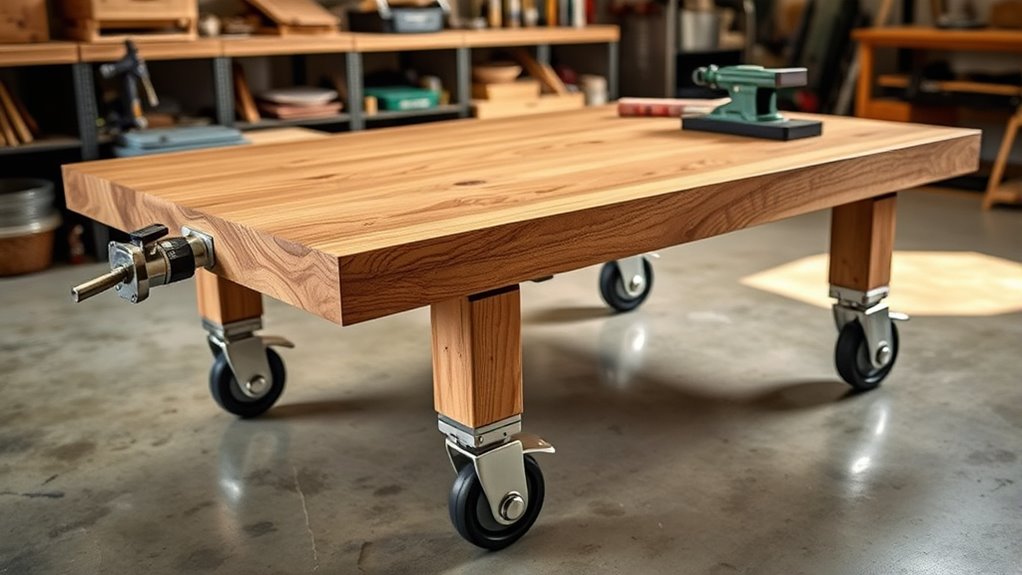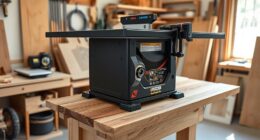To build a mobile workbench with rock-solid locking casters, start by selecting heavy-duty casters made from rubber or polyurethane that offer strong locking mechanisms. Attach them securely to a sturdy frame built from steel or solid hardwood to guarantee stability and durability. Make sure the casters swivel for easy maneuvering, but lock firmly when needed. Proper assembly and alignment are essential for stability and mobility. Continuing will reveal detailed steps to create your ideal versatile workbench.
Key Takeaways
- Select heavy-duty rubber or polyurethane casters with reliable locking brakes for stability during work.
- Use a sturdy frame made from steel, hardwood, or reinforced plywood to support heavy loads and ensure durability.
- Ensure casters are properly aligned and securely fastened to the workbench frame for stability and safety.
- Opt for swivel casters to facilitate easy maneuvering around your workspace.
- Confirm that locking mechanisms engage smoothly and hold the workbench firmly in place during use.

Ever wondered how to create a sturdy, portable workspace that keeps your tools organized and accessible? Building a mobile workbench is a practical solution, but the key to success lies in choosing the right caster selection and workbench materials. When selecting casters, you want to prioritize durability, load capacity, and locking mechanisms. Heavy-duty casters with locking brakes ensure your workbench stays put when you need stability and easily moves when you want portability. Look for casters made from robust materials like rubber or polyurethane, which provide smooth movement and resist wear and tear over time. Swivel casters allow for easy maneuverability, but don’t forget to include locking mechanisms to secure the workbench in place during use. This combination guarantees your workspace remains steady when you’re working on projects that demand precision.
Next, consider your workbench materials carefully. The material you choose impacts not only the workbench’s durability but also its weight and ease of mobility. Popular options include hardwoods like maple or oak, which are sturdy and resistant to damage, or plywood with a solid core, offering a balance between strength and affordability. Metal frames, often made from steel or aluminum, add stability and longevity, especially if you’re planning to work with heavy tools or materials. If you want a lightweight option, consider composite materials or lighter wood species, but make sure they can withstand the rigors of your tasks. Reinforcing your workbench with a thick, durable top surface—such as a butcher block or sealed plywood—provides a reliable work area that can handle cutting, hammering, or drilling without warping or damage. Additionally, selecting commercial-grade materials can enhance the overall robustness and longevity of your workbench, especially if it will be subjected to frequent heavy use.
Combining the right caster selection with quality workbench materials ensures your project is both functional and long-lasting. Once you’ve picked the ideal casters and materials, focus on proper assembly. Securely attach the casters to a sturdy frame, ensuring they’re aligned and tightly fastened. Double-check the locking mechanisms to confirm they engage smoothly and hold the workbench steady. When finished, your mobile workbench will be easy to move around your workspace, yet stable enough to handle any task. With thoughtful caster selection and the right materials, you’ll create a versatile, reliable station that adapts to your needs, whether you’re working in a garage, workshop, or craft room.
Frequently Asked Questions
How Do I Prevent the Workbench From Moving Unintentionally?
To prevent your workbench from moving unintentionally, focus on proper caster installation to guarantee a secure fit. Choose locking casters designed for stability, and always engage the locks when you’re using the workbench. For added stability, consider placing wheel chocks or leveling the casters on uneven floors. Regularly check the caster locks and tighten any loose hardware, maintaining ideal workbench stability during use.
Can I Customize Caster Sizes for Different Workbench Weights?
Sure, because choosing the perfect caster size is as easy as picking a hat, right? In reality, caster customization depends on your workbench’s weight capacity and the terrain it’ll face. Heavier workbenches need larger, sturdier casters to prevent sagging or failure. Always match caster size with your workbench’s weight capacity for safe, smooth mobility. Ignoring this can turn your mobile workspace into a wobbling disaster—so choose wisely!
Are There Specific Maintenance Tips for Locking Casters?
To keep your locking casters in top shape, regularly check and apply caster lubrication to guarantee smooth operation. Always follow lock engagement tips, like fully engaging and disengaging the locks to prevent wear. Keep the casters clean from debris and inspect for damage. Proper maintenance helps extend their lifespan and ensures reliable locking when you need stability, making your workbench safer and more efficient.
What Safety Precautions Should I Take During Construction?
When constructing your workbench, prioritize safety by wearing personal protective gear like gloves and eye protection. Keep your workspace organized to prevent accidents and make sure tools are stored properly. Use proper techniques and tools, and follow instructions carefully. Take your time, and don’t rush the process. By staying alert and maintaining a clean, organized workspace, you minimize risks and create a safer environment during your project.
How Do I Choose the Best Caster Material for Outdoor Use?
When choosing the best caster material for outdoor use, consider outdoor durability and ease of caster installation. You want casters made from corrosion-resistant materials like polyurethane or rubber, which withstand moisture and rough terrain. These materials guarantee smooth movement and longevity, even in harsh weather. Opt for heavy-duty casters designed for outdoor environments, and make certain they can handle your workbench’s weight. This way, your mobile workbench stays stable and reliable outside.
Conclusion
Now your mobile workbench is like a trusty steed—ready to carry your projects wherever they lead. With rock-solid locking casters ensuring stability and smooth mobility, you’ve created a versatile, durable workspace that moves with you. Just remember, this isn’t just a piece of furniture; it’s your workshop’s backbone, supporting your craftsmanship and fueling your creativity. Keep it sturdy, keep it ready, and let it steer your projects to success.








